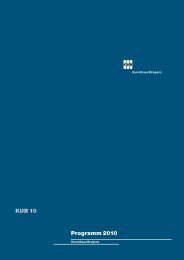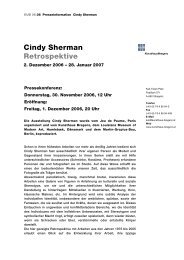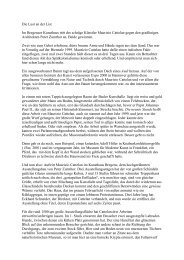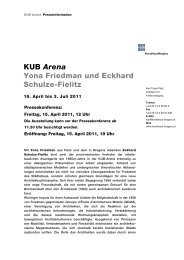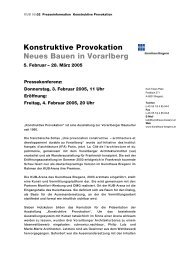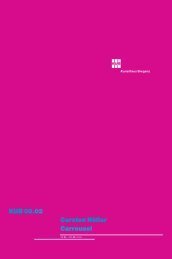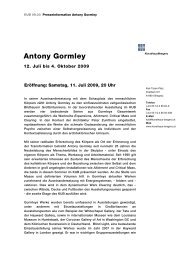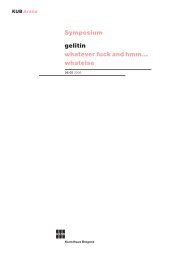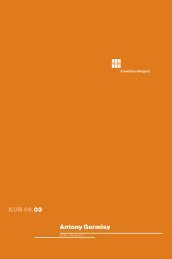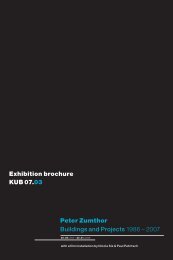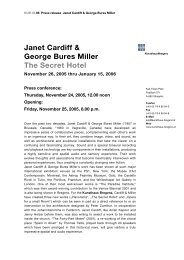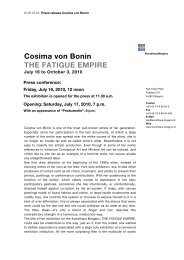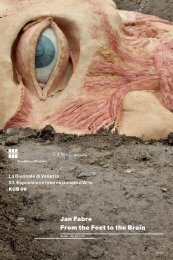Richard Serra Drawings – Work Comes Out of Work
Richard Serra Drawings – Work Comes Out of Work
Richard Serra Drawings – Work Comes Out of Work
Create successful ePaper yourself
Turn your PDF publications into a flip-book with our unique Google optimized e-Paper software.
2/2<br />
KUB 08.03 Press release <strong>Richard</strong> <strong>Serra</strong><br />
experience the critical balance <strong>of</strong> different forces and whose large-scale<br />
dimensions impart a strong physical and emotional experience.<br />
<strong>Serra</strong>’s first solo exhibition in 1969 at the Leo Castelli Gallery in New York<br />
was followed by many large international presentations <strong>of</strong> his sculptural<br />
work, landscape projects, and site-specific installations using his primary<br />
material: steel. After his large-scale retrospective at the Museum <strong>of</strong><br />
Modern Art in 2007, <strong>Richard</strong> <strong>Serra</strong> is currently showing “Promenade,” the<br />
monumental sculpture he created for the Grand Palais in Paris.<br />
Since 1971, <strong>Serra</strong> has focused not only on sculptural works, but also on<br />
large-scale drawings using various techniques. These are as important to<br />
him as his sculptures, and as the artist himself explains: “I like to draw. It<br />
is an activity I rely on, a dependency <strong>of</strong> sorts. Drawing gives me an<br />
immediate return for my effort and the result is commensurate with my<br />
involvement. It is an activity that requires solitude, it is the most<br />
concentrated space in which I work.”<br />
In another context, he calls drawing the source <strong>of</strong> his artistic activity, not<br />
least because it affords him the freedom to think about the elementary<br />
conditions <strong>of</strong> his sculptural pieces without needing to rework them. <strong>Serra</strong><br />
has always drawn. He was accepted to the Yale School <strong>of</strong> Art based on the<br />
drawings he submitted. The color he uses in his drawings is black. A dense<br />
layer <strong>of</strong> paintstick absorbs and dissipates light; what emerges is the mass,<br />
density, and volume <strong>of</strong> the drawing. “Black is a property, not a quality. In<br />
terms <strong>of</strong> weight, black is heavier, creates a larger volume, holds itself in a<br />
more compressed field. It is comparable to forging. […] To use black is the<br />
clearest way <strong>of</strong> marking against a white field.” (<strong>Richard</strong> <strong>Serra</strong>) In other<br />
words, the artist finds it is also the clearest way <strong>of</strong> indicating something<br />
without triggering associations because black is interpreted as a material<br />
substance rather than a color. Unlike the site-specific “Wall <strong>Drawings</strong>,”<br />
which, rendered directly onto cloth, operate with the proportions and<br />
scales <strong>of</strong> the existing architecture, <strong>Serra</strong>’s drawings on paper are not<br />
bound by context. The frame serves, instead, to separate the paper<br />
drawing from the wall.<br />
<strong>Richard</strong> <strong>Serra</strong>’s drawing material is the paintstick, a wax-like grease<br />
crayon. <strong>Serra</strong> melts several paintsticks to form large pigment blocks. This<br />
transformation allows him to apply the black material in broad, dense<br />
strokes. Warming or melting the material for his drawings, he applies it<br />
either directly onto the paper with large sweeps <strong>of</strong> his arm, or he uses a<br />
window-screen as an intermediary surface through which he presses the<br />
color. In his recent “Solids,” <strong>Richard</strong> <strong>Serra</strong> goes a step further. “Melted<br />
paintstick is poured onto a hard surface on the floor. Sometimes, not<br />
always, a sheet <strong>of</strong> window-screen is placed on top <strong>of</strong> the liquid paintstick.



